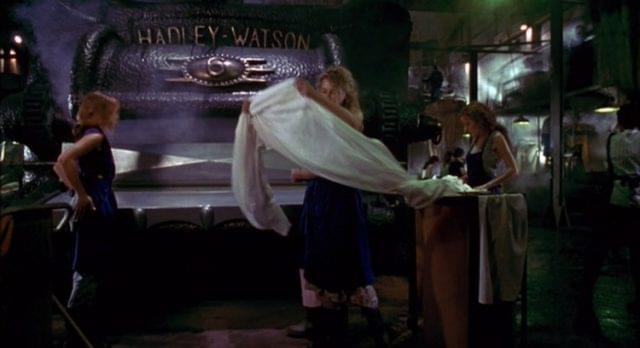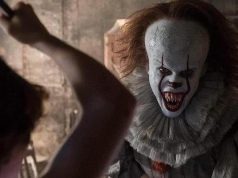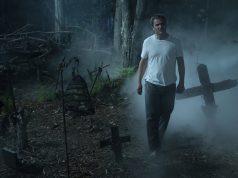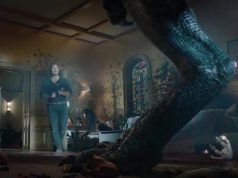
The basic concept of many horror movies is that there is a monster of some kind, and the heroes have to destroy it or be killed by it. Sometimes the monster is something that’s obviously frightening, like a werewolf or vampire. Sometimes it’s a creature that is ordinarily unthreatening but has been made dangerous by its temperament or enlarged size or increased numbers — a rabid dog, perhaps, or a giant lizard, or a swarm of bees.
Or, in the case of “The Mangler,” an industrial laundry press machine.
You are probably wondering why an industrial laundry machine would be scary. It is a stationary object, which means all you have to do to avoid being killed by it is not go near it. If that is what you are thinking, then congratulations! You are smarter than the people who made “The Mangler.”
It was based on a short story by Stephen King, who, despite being the master of modern horror writing, has had terrible luck with his movie adaptations. This is the result of a curse placed upon him many years ago by a gypsy. (The other part of the curse is that each of his monthly columns for Entertainment Weekly is doomed to be on a dull topic on which he has nothing interesting to say.) The short story presumably made more sense than the movie, which has been padded out to fill the running time. Still, you can’t get away from the fact that it’s about a laundry machine that kills people. On King’s list of effective monsters, this one ranks way down below Giant Spider That Represents All Fears.
The first problem is that the machine is hard to define. It’s a big contraption that presses and folds sheets and linens and things. The people in the movie call it a “speed iron.” It’s technically known as a “laundry press.” The point is, it’s a device that most people are completely unfamiliar with, and a good movie monster needs to be something we can relate to. A giant rabbit! Now that’s scary. We’ve all seen rabbits, and we can imagine what a giant one would look like. It would look like a rabbit, only bigger. But an industrial laundry press ironing machine device thingee? What is that?
This vagueness has led some people to refer to the film as “the one about a killer washing machine.” But this is incorrect. A killer washing machine? Come on. That would be stupid.
The film is set in a small Maine town that is populated by rednecks, inbreds, and idiots. In other words, it’s set in a small Maine town. (Just kidding, Mainerds! I love ya!) There’s a company called Blue Ribbon Laundry with a factory-like environment that has bedraggled women running around shouting at each other as they, um, do laundry, I guess. It’s not really clear what they do. It looks like a sweatshop. But at the center of the warehouse floor is a behemoth machine that apparently presses and folds things. And when one of the employees cuts her hand on one of its pieces, the machine gets a taste for blood and soon thereafter eats somebody who gets too close to it.
It’s a horrific accident, of course, and everyone is devastated. The local safety board examines the machine and quite reasonably declares the lady-smashing to have been a fluke. There is no reason to suspect foul play or supernatural forces. This does not stop the town’s only cop, Hunton (Ted Levine), from suspecting foul play, nor his friend Mark (Daniel Matmor) from suspecting supernatural forces. What’s funny is that Hunton thinks Mark is crazy for thinking demons are involved, and Mark thinks Hunton is silly for thinking it was murder, when really both of them are morons for thinking it was anything other than an accident.
(Yes, I understand that it was not actually an accident. But Hunton and Mark had no reason to think that, other than the movie needing them to think it. Please don’t make me explain EVERYTHING to you.)
A word on this cop, Hunton. He is the quintessential main character for a bad movie in that he is mean and unlikable. He is even surly to his mailman, who surely has never done him any harm. It does not help that Hunton is played by Ted Levine, who is best known for playing Buffalo Bill, the junk-tucking psycho killer in “Silence of the Lambs.” Levine’s voice sounds strangled and phlegmy, like he just ate a big bowl of ice cream and half of it’s still in his throat. He is not the sort of actor you want as your protagonist if you were hoping for people to enjoy your movie, or even watch it with both eyes.
Anyway, Hunton’s friend Mark is a long-haired hippie type who, get this, worked at an industrial laundry in college! So he knows all about large pressing folding ironing machine gizmos like the one at Blue Ribbon Laundry. He also has a book about the occult, and the book tells him that the machine is probably possessed by a demon, which I guess is the answer you’d expect to find when you look for answers in a book about demons, like when you go to a chiropractor and he tells you that all your problems are attributable to a lack of chiropractic care. Mark’s hands-on experience with industrial machine foldy ironing laundry whatzits, coupled with his perusal of this occult book, convinces him that the machine at Blue Ribbon has a hunger for the blood of virgins. And from the looks of him, if anyone knows virgins, it’s Mark.
The owner of Blue Ribbon is a cantankerous old man named Gartley, played by Robert Englund, best known as Freddy Krueger. Here he wears old-age makeup and clambers around wearing braces on his legs, which is a hint at the marriage between man and machine that will figure heavily into the movie later on, after you’ve stopped paying attention. Gartley owns everyone in town, including the mayor and the city council, and he’s well aware that his fold-sort-iron-press-laundry-machine doodad has the devil in it. In fact, he and the town’s prominent citizens have been sacrificing their 16-year-old virgin daughters to it in exchange for financial prosperity for generations! There, now you don’t have to watch the movie to find out what happens.
“The Mangler” follows the basic template of a regular monster movie, with deaths occurring at regularly timed intervals. The difficulty, of course, is that the monster in this movie cannot pursue its victims; the movie must bring them to it. So even though the machine’s propensity for ensnaring and flattening hapless bystanders has been well established, people continue to hang around it and lean against it, thus enabling themselves to be eaten — and good riddance to anyone dumb enough to be devoured by an immobile object, I say. Serves you right.
OK, at the end of the movie, Hunton and Mark do something to REALLY enrage the machine, and it actually comes to life and chases them around the factory, and I wish I were kidding. It bites Mark in half, which is mildly awesome, but not enough to compensate for the dumbness of the situation. Can I pretend it never happened? I’m fine with that if you are.
P.S.: Somehow an evil refrigerator is also involved. Yes, an evil refrigerator. A pair of bumbling morons were taking it from Blue Ribbon Laundry (does Blue Ribbon Laundry also sell refrigerators?) and delivering it somewhere in town when they bumped against the laundry press. Later, supernatural blue evil lights come out of the refrigerator, which has been left on someone’s lawn, which is evidently what they do with major kitchen appliances in Maine. The reason I didn’t mention any of this earlier is that I was embarrassed to admit I didn’t understand it.
— Film.com





